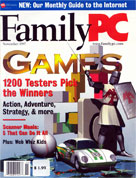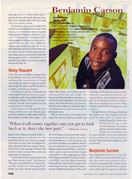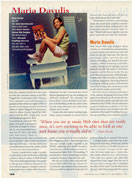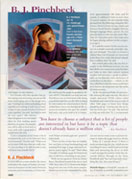
Kid coders share their secrets for building wicked-cool web sites By Michelle Megna
Webmasters beware: Several next-generation cyber-teens (and preteens) have been spotted creating the kind of Web sites for fun and profit that would send the wiliest of adult Webmasters scurrying for the source code.
These wired wizards know surfing the Web isn’t nearly as cool as actually creating your own personalized piece of it. And while Jupiter Communications reports that by the year 2002, 47 percent of children ages two to 17 will be online and 75 percent of teens will use the Internet, these kids have already taken the next step: They’re in creative control.
To introduce you to our worldly Web wizards, we’ve done profiles of each: Vinny Pasceri, 17, of New York, former Sachem High School Webmaster; Benjamin Carson, 15, of Plugged In, a group that provides computer training, services, and access for his East Palo Alto, California, community; Maria Davulis, 14, of the Massachusetts-based Teen Voices Web site, the on-line version of the magazine featuring articles, poetry, and artwork written by teenage girls; and B. J. Pinchbeck, 10, of Pennsylvania, author of an award-winning homework help site.
Vinny Pasceri
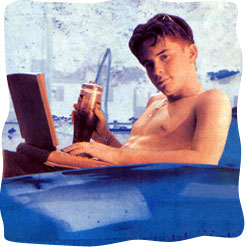
Age: 17
Site: www.sachem.edu
Claim to Web Fame:
Former Sachem High School Webmaster
Web Wizard Bag of Tricks:
Adobe Photoshop
(Adobe Systems, 800-833-6687 or 408-536-6000; www.adobe.com)
Microsoft FrontPage
(Microsoft, 800-426-9400 or 206-882-8080; www.microsoft.com/frontpage/)
Vinny Pasceri, an affable teenage from Long Island, is the type of kid who can spearhead the construction of a high school Web site without support of funding, though he’s quick to point out that he is neither a nerd nor an Einstein.
“I do have a social life. I hang around with my girlfriend more than my computer. I play the violin. You probably think I’m a geeky guy sitting in front of my computer all day,” he said. “And you know, I’m not a super genius or anything.”
As the founder of a club called the Web Slingers in his junior year, Pasceri organized the creation of a high school Web site that has had 2.8 million hits to date – not bad for a site without corporate insider information, games, or nude pictures. The ingredients for the site’s success are simple: It provides resources that are integral to a high school kid’s life, for example, homework, lunch, and tutoring; it bolsters the school’s overall communication; and, most important, it’s interactive.
“Lots of school sites are just pictures and text. How boring is that?” said Pasceri. “The key to a great Web site is interactivity. What can you do to draw people in?” In this case, a lot. Pasceri says he and his fellow Web Slingers revised the site several times before they got it right. The Homework Network allows students to access homework assignments for upcoming weeks; the Online Writing Lab puts students in touch with peer counselors; there’s a classifieds section; and you can check out the lunch menu.
Still, it wasn’t easy to reach the point where the site was running smoothly and the Web Slingers had earned some respect and could garner the support of teachers and administrators. Since the group had no advisor, funding or equipment, Pasceri hit up local businesses to sponsor the Web Slingers and persuaded them to donate a video-capture card and a Kodak Digital Camera DC-25. The original group of five Web Slingers basically trained one another in HTML, Unix, and Adobe Photoshop. Eventually the school district approved a technology bond that upgraded computers and enabled the purchase of Microsoft FrontPage and Photoshop training books. Aside from corporate help, Pasceri says setting deadlines, documenting workflow, and not being afraid to change things if they aren’t working are the best things to keep in mind when setting out on such a project.
Though the site is thriving, and starting this school year Web Slingers will earn credit for their work, it’s evident that Pasceri learned a lot more than HTML from his gig as High school Webmaster. “It was great getting recommended for scholarships, but I would give it up for just being able to have fun, make new friends, and have that whole experience,” he said. “That kind of knowledge stays with you forever.”
Benjamin Carson
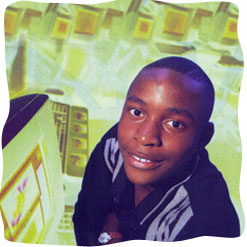
Age: 15
Site: www.pluggedin.org
Claim to Web Fame:
Plugged In Graphic Guru
Web Wizard Bag of Tricks:
Adobe PageMill, Photoshop, and Premier
(Adobe Systems, 800-833-6687 or 480-536-6000; www.adobe.com)
Infini-D
(MetaCreations, 800-472-9025; www.metacreations.com)
“When it all comes together and you get to look back at it, that’s the best part.” – Benjamin Carson
When Benjamin Carson, 15, of East Palo Alto, California, meets with bank executives, they are the ones seeking his advice. Carson, a young man with a mature vision, lends his keen eye and Web savvy to businesses and nonprofit agencies in the East Palo Alto commercial district that want to make their presence known on the Web. Plugged In, a community center that provides computer access and training to a population that otherwise might not be exposed to technology, recently formed an offshoot called Plugged In Enterprises, which is where Carson honed his Web-page-building skills. “Right now, we do multimedia production, desktop publishing, and make Web pages. Our goal is to become profitable enough to eventually be an independent business run by teens and teens only,” said Carson. “There’s a lot of business in the area, so we never run out of clientele.” There’s even a lot of business out of the area – he has worked for several businesses across the nation, and he even has one international clien.
Carson is particularly adept at graphics and sticks to the motto that simplicity is beauty when it comes to web design. “The most challenging thing is the graphics that go into a Web site, because it’s the most interesting part. Graphics and animation take more creative effort than anything else,” he said. “You need nice colors that are pleasing to the eye, but nothing too wild and cluttered.” For example, for Ocean Bank, Carson decided to put a picture of the building on the site and to come up with a logo. He used a wave with a drop shadow and a border.
Carson, who also enjoys running track, began using computers in school in first grade; in fourth grade, he was recruited to do a Plugged In project. Now the tools Carson uses include Adobe PageMill as an HTML authoring tool; Adobe Premier, which he uses with Photoshop to create animations; and Infini-D for 3-D modeling. “I also like Xres; it’s like Photoshop but there’s a bunch of brushes. It has style,” he said.
But you need more than style and software to build a killer Web site. Carson’s advice: Know your audience but remember that you need appeal to all people; be creative; have fun; and above all, have an open mind about what will work.
“Sometimes if you have a demanding client who wants their graphics a specific way, you have to keep going back to the drawing board until you get it right,” he said. ‘When it all comes together and you get to look back at it, that’s the best part.”
Maria Davulis
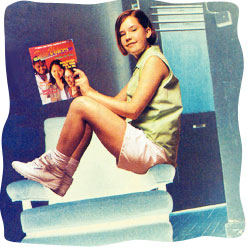
Age: 14
Site: www.teenvoice.com
Claim to Web Fame:
Teen Voices' Wonder Woman Web Designer
Web Wizard Bag of Tricks:
Microsoft FrontPage
(Microsoft, 800-426-9400 or 206-882-8080; www.microsoft.com/frontpage/)
“When you see so many Web sites that are really nice, it’s very exciting to be able to look at one and know you actually did it.” – Maria Duvalis
Teen Voices Web page designer Maria Davulis, 14, of Dorchester, Massachusetts, is a matchmaker, but not the sort who will hook you up with a hot date. Her job is to pick images, colors, and fonts that will convey the feeling and mood of the site’s content – which, by the way, is a bit loftier than a lineup of new lipsticks and nail polish for the fall. The motto of Teen Voices magazine and its Web site is this: You are more than just a pretty face. With that Philosophy, Teen Voices provides an alternative to fashion magazines, focusing primarily on original writing, poetry, and artwork created by teenage girls about issues such as self-esteem, racism, and sexism.
Given the diverse and personal nature of the content, designing Teen Voices Web pages is an ethereal sort of exercise but one that Davulis does deftly, especially since she ditched her first HTML tool, the shareware program HotDog (available at ZD Net Shareware Library, www.hotfiles.com). She switched to Microsoft’s FrontPage because, she says, HotDog is too confusing for beginners primarily concerned with layout.
“I design pages, perk them up, make things look interesting. If there are a whole bunch of articles on all different sorts of topics, I can pick an image and the right color for every single one – bold, calm, soft, funky, whatever it is,” said Davulis. “One time in a poem I put the word slapped four times bigger than the rest of the text and in strong color to highlight the effect of the word.” On the other hand, she uses calm blues and purples for poems with happy or calm themes.
For Davulis, who also spends time in-line skating and swimming, layouts are the most challenging part of the design process. “Getting four colors and putting them together and making it look nice is harder than it may sound, because if it doesn’t come together,” she said, ‘you have to start all over again.” She advises other designers to try out initial ideas by first making quick sketches on paper. Eventually, yu will be able to look back at your work with a great deal of satisfaction, she said.
“I use a computer at my house a lot to do homework, and on the Internet I do a lot of research,” Davulis said. ‘When you see so many Web sites that are really nice, it’s very exciting to be able to look at one and you know you actually did it.”
B. J. Pinchbeck
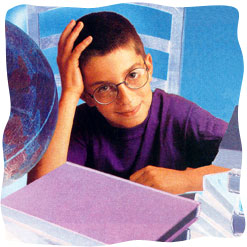
Age: 10
Site: tristate.pgh.net/~pinch13/index.htm
Claim to Web Fame:
Founder and manager of B.J. Pinchbeck's Homework Helper
Web Wizard Bag of Tricks:
HotMetal
(SoftQuad, 800-360-8454 or 416-544-900; www.softquad.com)
“You have to choose a subject that a lot of people are interested in but have it be a topic that doesn’t already have a million sites." – B. J. Pinchbeck
If you’re still not certain whether the moon symbolizes the states of human development in literature or the realm between conscious and unconscious, or if you simply need to get the angle on geometry, 10-year-old B. J. Pinchbeck can help you out. Pichbeck was so frustrated with doing convoluted searches on the Web looking for information for school projects that he wished there were a site that had all the resources he needed in one spot. He couldn’t find such a site, so he built it: B. J.s Homework Helper at tristate.pgh.net/~pinch13/index.html.
“There are lots of sites that are helpful, but you have to keep bookmarking and jumping from page to page and search engine to search engine,” he said. ‘That’s when I thought of making a page for homework that would have everything in place.”
With encouragement from his father Bruce, Pinchbeck launched the site in April 1996. Since then, B. J.’s Homework Helper has grown into one of the most comprehensive research sites maintained by a kid, with approximately 380 links and 83 awards. In addition to links to more than 20 search engines, the site includes links grouped into the following categories: Reference, News/Current Events, Math and Science, Social Studies, English, History, Foreign Language, Music, and Art. He even provides links to a few fun sites under Playtime. B. J. has come quite a few steps since he began playing solitaire at age 6.
B. J. said the reason for his success centers on a simple economic principle: supply and demand. “You have to choose a subject that a lot of people are interested in but have it be a topic that doesn’t already have a million sites,” he said.
But content plays a key role, too. For example, in the Reference section, you can find all the core sources you need, but there are links to sites that convert various weights and measures, a guide to philosophy on the Internet, and a dictionary of symbolism in literature – which, but the way, will tell you that the moon symbolizes both human development and the realm of consciousness.
As for the nuts and bolts, he says actually creating the page was easy. He used a simple shareware HTML editor called HotMetal and viewed the source code of other Web pages to learn how things should be set up. “Getting onto the server was the tricky part,” he said. “My dad had to help me with that.” B. J. recommends you not to use too many icons or pictures because it makes the pages load too slowly.
Today, B. J. spends about 15 hours a week maintaining the site, which means searching for more useful homework help links and answering 40 or so daily e-mail messages he receives. A kid who obviously follows through on his ideas, Pinchbeck said, “You can’t just make something like this, then stop doing it.”
- Michelle Megna is a FamilyPC associate editor.
